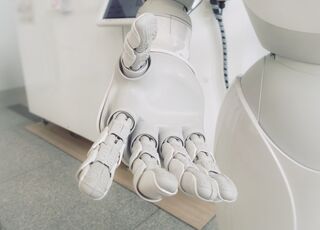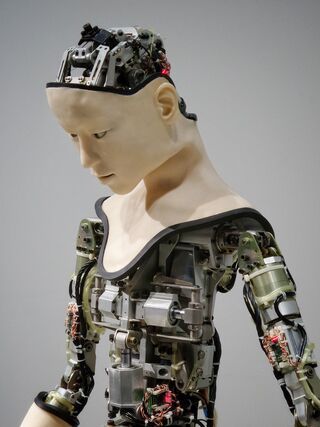Relationships
The Psychology Behind Synthetic Love and Robotic Romance
Why do some people develop romantic attachments to synthetic humans?
Posted December 10, 2021 Reviewed by Ekua Hagan
Key points
- Falling in love with synthetic humanoids has been a long-standing fascination within popular culture.
- As loneliness rises, so too have the number of people who have developed romantic relationships with non-human robots.
- Research suggests this is in part due to how loneliness tweaks social cognition, making the minds of robots appear deeper and more realistic.
This is part 4 of a multi-part series on the neuromarketing of loneliness. Part 1 examines the Psychology and Business of Loneliness, while Part 2 explores The Rising Loneliness Economy. Part 3 looks at the unexpected ways that loneliness impacts our social lives, and specifically the Psychology of Parasocial Relationships. The penultimate piece, Part 4, looks at The Psychology Behind Our Attachment to Robots.
As people spend more and more time with robots, it's almost inevitable that things will, for certain people, take a romantic turn. Pepper, and others like them who are built for hospitality, have largely avoided this kind of attention. But for other kinds of models, this is a very different story. More and more, people find themselves falling for synthetic humanoids.
This is a topic that popular culture has long been fascinated with. The Stepford Wives in 1975 was the first major film to explore this theme, taking the idea of the subservient suburban housewife to a robotic extreme. Blade Runner and Ex-Machina both dive into robotic love stories with a heavy emphasis on the love-based Turing Test. Spike Jonze's Her explores the idea of falling in love with a disembodied operating system.

Whether or not robots can be programmed to “love” is open to debate. But for a growing number of people, programming isn’t needed at all.
Enter RealDolls, the best-selling model lifelike synthetic mannequins from Abyss Creations in San Marcos, California. The company allows customers to construct their ideal partner from scratch. For about $7,000, you can customize features such as eye color, hair, height, body type, and more. RealDolls are primarily seen as “sex dolls” (and yes, they are anatomically accurate).
Here, there is no programming at all and no direct interactivity. More and more, however, especially as loneliness increases, people turn to them for full-on romance.
Clearly, the idea of being in a relationship with a doll is intuitively odd. But it would be dismissive to label these people as being fundamentally and inexplicably "strange." Instead, there’s a science to it. It’s where social cognition, robotics, and parasocial relationships meet.
The Psychology of Loneliness and Its Influence on Robotic Romance
Understanding this phenomenon means addressing this key question: When someone feels that they are “in love” with their doll, what is that love? Again, it comes back to social cognition: creating an internal model of another person’s mind.
In real relationships, and even in parasocial relationships, this model is informed by the person’s overt personality; we use what they say and do as input to help construct this model. So even if we’re the ones building the model, the other person is contributing to it.
But in the case of dolls, however, there is no such input. It’s a lifeless doll, after all. The model is built on input which is also generated in the person’s imagination. People in relationships with dolls describe this best. Consider the following description from “DaveCat," in an interview on the podcast Love & Radio. He describes the dynamics of his relationship with his doll named “Shi-Chan”:
In an organic relationship, there are two people in love. And one of them—maybe both of them—has a perception of the person they’re attracted to. They’re attracted to that perception and not necessarily to the person who they actually are. It’s an image that the person has built up in their mind.
And then if they do something unexpected, you’re thrown for a complete loop. But you don’t get that with a synthetic. Everything is upfront. There’s no deceit. There’s no nasty surprises. Whatever you make as their personality—that's what you get.
Loneliness tends to be a key component of these relationships. As DaveCat describes, Shi-Chan makes the “difference between being alone, and being lonely.”

When people go a long time without food, the body resorts to drastic measures to gain sustenance. In a process known as “autophagy,” the body’s cells start eating bits and pieces of itself. When it doesn’t get what it needs from the outside world, it turns inward.
An analogous process seems to happen with the need for social connection. It’s as if, starved of the need for human connection, the mind turns inward. It resorts to internal means to satisfy this need. It creates a rich, detailed, model of the mind which becomes the object for human connection. The doll has become a kind of surrogate for the person’s own imagination.
DaveCat distills this in the following way: “There’s the perfect phrase that I still use to this day: 'dolls reflect the love that you give them.' They’re in love with you because you’ve given them minds.”
Parasocial Relationships, Loneliness and Robotic Romance
You can think of any parasocial relationship like a movie that the person is generating in their own head. The person is both the director and the movie’s main character.

DaveCat, for example, wove a complex backstory for Shi-Chan: the daughter of a Japanese father and English mother who grew up in Manchester, UK. Each day is a new scene unfolding in his epic drama. The doll then, is the projector screen that this movie appears on; it brings the movie to life.
With loneliness increasing, the industry will only become more plentiful, and consumer solutions will become more varied. It's human nature to seek connection. As we’ve seen, these solutions span simple companionship, hospitality, and as with DaveCat and others, romance. But far from being an inexplicable personality quirk, these bonds are a result of natural social cognitive processes turned inwards, and of market innovations filling an unmet need for human connection.
For many, technology is more than capable of filling this need. And as the synthetic becomes more sophisticated, more human-like, and more tailored to our needs, the inanimate could play a larger role than ever.
This post also appears on the consumer psychology blog NeuroScience Of
References
Liberati, N. (2021). Phenomenology and Sex Robots: A Phenomenological Analysis of Sex Robots, Threesomes, and Love Relationships. International Journal of Technoethics (IJT), 12(2), 86-97.
Nass, C., & Moon, Y. (2000). Machines and mindlessness: Social responses to computers. Journal of Social Issues, 56(1), 81–103.
Steinberg, N. (July 2016) “Why Some Robots Are Created Cute,” Mosaic Science, 13 July 2016, mosaicscience.com/story/why-some-robots-are-created-cute/.
“Value of Social and Entertainment Robot Market Worldwide from 2015 to 2025 (in Billion U.S. Dollars),” Statista, May 2019
Yam, K. C., Bigman, Y. E., Tang, P. M., Ilies, R., De Cremer, D., Soh, H., & Gray, K. (2020). Robots at work: People prefer—And forgive—Service robots with perceived feelings. The Journal of Applied Psychology.




